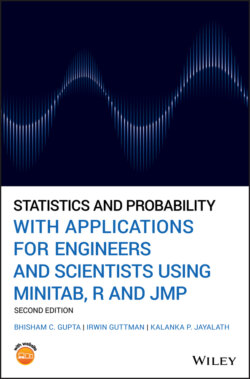Читать книгу Statistics and Probability with Applications for Engineers and Scientists Using MINITAB, R and JMP - Bhisham C. Gupta, Irwin Guttman - Страница 95
2.7.4 Coefficient of Variation
ОглавлениеThe coefficient of variation is usually denoted by and is defined as the ratio of the standard deviation to the mean expressed as a percentage:
(2.7.4)
where is the absolute value of the mean. The coefficient of variation is a relative comparison of a standard deviation to its mean and is unitless. The cv is commonly used to compare the variability in two populations. For example, we might want to compare the disparity of earnings for technicians who have the same employer but work in two different countries. In this case, we would compare the coefficient of variation of the two populations rather than compare the variances, which would be an invalid comparison. The population with a greater coefficient of variation, generally speaking, has more variability than the other. As an illustration, we consider the following example.
Example 2.7.3 A company uses two measuring instruments, one to measure the diameters of ball bearings and the other to measure the length of rods it manufactures. The quality control department of the company wants to find which instrument measures with more precision. To achieve this goal, a quality control engineer takes several measurements of a ball bearing by using one instrument and finds the sample average and the standard deviation to be 3.84 and 0.02 mm, respectively. Then, he/she takes several measurements of a rod by using the other instrument and finds the sample average and the standard deviation to be 29.5 and 0.035 cm, respectively. Estimate the coefficient of variation from the two sets of measurements.
Solution: Using formula (2.7.4), we have
The measurements of the lengths of rod are relatively less variable than of the diameters of the ball bearings. Therefore, we can say the data show that instrument 2 is more precise than instrument 1.
Example 2.7.4 (Bus riders) The following data gives the number of persons who take a bus during the off‐peak time schedule (3–4 pm.) from Grand Central to Lower Manhattan in New York City. Using technology, find the numerical measures for these data:
| 17 | 12 | 12 | 14 | 15 | 16 | 16 | 16 | 16 | 17 | 17 | 18 | 18 | 18 | 19 | 19 | 20 | 20 | 20 | 20 |
| 20 | 20 | 20 | 20 | 21 | 21 | 21 | 22 | 22 | 23 | 23 | 23 | 24 | 24 | 25 | 26 | 26 | 28 | 28 | 28 |
